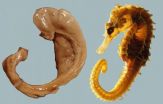Study identifies enzymes that help fix cancer-causing DNA defects
2014-04-23
(Press-News.org) Purdue University researchers have identified an important enzyme pathway that helps prevent new cells from receiving too many or too few chromosomes, a condition that has been directly linked to cancer and other diseases.
Mark Hall, associate professor of biochemistry, found that near the end of cell division, the enzyme Cdc14 activates Yen1, an enzyme that ensures any breaks in DNA are fully repaired before the parent cell distributes copies of the genome to daughter cells. This process helps safeguard against some of the most devastating genome errors, including the loss of chromosomes or chromosome segments.
"It only takes one cell to start a tumor," Hall said. "This study gives us a platform for figuring out exactly what these enzymes are doing in human cells and how they impact genome stability and the avoidance of cancer."
Cdc14 has been linked to DNA damage repair in humans, but exactly how the enzyme helps preserve the genome and which proteins it regulates in this process have not been known.
Hall and his fellow researchers developed a novel method of identifying the protein substrates upon which Cdc14 acts. Cdc14 regulates the function of other proteins by removing phosphate, a small chemical group, from them. Using Cdc14 in baker's yeast - which is very similar to human Cdc14 - the team studied the activity of the enzyme on a wide variety of synthetic substrate molecules, looking for similar features among the molecules most preferred by Cdc14.
"We were basically trying different keys in the lock to see which would fit the best," Hall said.
The team identified the most common structural features on molecules targeted by Cdc14 and used bioinformatics tools to pinpoint matching features in yeast proteins. Yen1 proved to be the best match, and further tests confirmed its role as a substrate of Cdc14. Yen1 is the first Cdc14 substrate involved in DNA repair to be identified.
Hall said the remarkable similarity of these enzymes in yeast and humans makes it likely that this method could be used to identify targets of Cdc14 in humans as well.
"Despite belonging to extremely different species, the 'lock' in yeast and human Cdc14 enzymes is exactly the same," he said. "That gives us confidence that we can use this strategy to identify substrates of human CDC14 and how they work to control DNA repair processes and prevent cancer."
Hall said understanding Cdc14's role in DNA repair and how the enzyme binds to its substrates could be used to develop more effective chemotherapeutic weapons against cancer. Many chemotherapeutic drugs work by producing such extensive DNA damage in cancer cells that they kill themselves. Designing a chemical that mimics the features of a Cdc14 substrate would help block Cdc14 from repairing damaged DNA in cancer cells, speeding their death.
"Developing Cdc14 inhibitory compounds could make certain cancer treatments more specific and potent," Hall said. "You could think of Cdc14 inhibitors as kryptonite to cancer cells, potentially weakening their ability to heal themselves and making them more vulnerable to chemotherapy treatment."
Hall also is exploring the possibility of using Cdc14 inhibitors to combat deadly fungal diseases in crops.
INFORMATION:The paper was published in Molecular Cell. A summary is available at http://www.cell.com/molecular-cell/abstract/S1097-2765%2814%2900128-2
Collaborators on the research include Purdue graduate students Christie Eissler and Brendan Powers, Lorraine Symington and Gerard Mazón of the Columbia University Medical Center and Sergey Savinov of the Purdue Center for Cancer Research.
Funding for the research was provided by the National Institutes of Health and the Purdue University Center for Cancer Research.
ELSE PRESS RELEASES FROM THIS DATE:
A key to enjoying massive online photo files may be giving up some control
2014-04-23
PITTSBURGH—The ability of individuals to store and instantly access thousands of their photos online has become a commonplace luxury, but the sheer size of these archives can be intimidating. Researchers at Carnegie Mellon University and Microsoft Research Cambridge, UK, have found people might actually enjoy their collections more by giving up a bit of control and learning to wait.
Their 14-month study showed that people reflected more on past events and developed a renewed interest in their online photos when a device called Photobox would randomly print four or five ...
AGU: Odds of storm waters overflowing Manhattan seawall up 20-fold, new study shows
2014-04-23
WASHINGTON, D.C. -- Maximum water levels in New York harbor during major storms have risen by nearly two and a half feet since the mid-1800s, making the chances of water overtopping the Manhattan seawall now at least 20 times greater than they were 170 years ago, according to a new study. Whereas sea-level rise, which is occurring globally, has raised water levels along New York harbor by nearly a foot and a half since the mid-19th century, the research shows that the maximum height of the city's "once-in-10-years" storm tide has grown additionally by almost a foot in that ...
Study finds long-term survival of human neural stem cells transplanted into primate brain
2014-04-23
Putnam Valley, NY. (Apr. 23 2014) – A team of researchers in Korea who transplanted human neural stem cells (hNSCs) into the brains of nonhuman primates and assessed cell survival and differentiation after 22 and 24 months found that the hNSCs had differentiated into neurons at 24 months and did not cause tumors.
The study will be published in a future issue of Cell Transplantation but is currently freely available on-line as an unedited early e-pub at: http://www.ingentaconnect.com/content/cog/ct/pre-prints/content-ct1117Antonucci2.
The hNSCs were labeled with magnetic ...
Scientists identify source of mysterious sound in the Southern Ocean
2014-04-23
Scientists have conclusive evidence that the source of a unique rhythmic sound, recorded for decades in the Southern Ocean and called the "bio-duck," is the Antarctic minke whale (Balaenoptera bonaerensis). First described and named by submarine personnel in the 1960s who thought it sounded like a duck, the bio-duck sound has been recorded at various locations in the Southern Ocean, but its source has remained a mystery, until now.
In February 2013, an international team of researchers deployed acoustic tags on two Antarctic minke whales in Wilhelmina Bay off the western ...
Autologous stem cell therapy improves motor function in chronic stroke victims
2014-04-23
Putnam Valley, NY. (Apr. 23, 2014) – People who have had a stroke, often suffer motor deficits with little potential to restore neurological function. However, a study conducted in Taiwan, that will be published in a future issue of Cell Transplantation, but is currently freely available on-line as an unedited early e-pub at: http://www.ingentaconnect.com/content/cog/ct/pre-prints/content-ct1168Chen, has found that when one group of stroke victims had their own peripheral blood stem cells (PBSCs) injected directly into the brain and a similar group did not, those who received ...
Too many chefs: Smaller groups exhibit more accurate decision-making
2014-04-23
The trope that the likelihood of an accurate group decision increases with the abundance of brains involved might not hold up when a collective faces a variety of factors — as often happens in life and nature. Instead, Princeton University researchers report that smaller groups actually tend to make more accurate decisions while larger assemblies may become excessively focused on only certain pieces of information.
The findings present a significant caveat to what is known about collective intelligence, or the "wisdom of crowds," wherein individual observations — even ...
Community-based weight loss program aids diabetes management
2014-04-23
Weight loss and control of blood sugar can reduce the risk of complications in patients with diabetes but this is difficult for many to achieve. A University of California, San Diego School of Medicine randomized controlled trial of obese adults with type 2 diabetes suggests that participants enrolled in a community-based structured weight loss program are able to shed more pounds, improve blood sugar control and reduce or eliminate insulin use and other medications compared to a control group.
"Support and a tailored lifestyle intervention have been shown to reduce cardiovascular ...
Physical activity keeps hippocampus healthy in people at risk for Alzheimer's disease
2014-04-23
COLLEGE PARK, Md. – A study of older adults at increased risk for Alzheimer's disease shows that moderate physical activity may protect brain health and stave off shrinkage of the hippocampus– the brain region responsible for memory and spatial orientation that is attacked first in Alzheimer's disease. Dr. J. Carson Smith, a kinesiology researcher in the University of Maryland School of Public Health who conducted the study, says that while all of us will lose some brain volume as we age, those with an increased genetic risk for Alzheimer's disease typically show greater ...
Chemical companies shore up supplement science
2014-04-23
As evidence mounts showing the potential health benefits of probiotics, antioxidants and other nutritional compounds, more and more people are taking supplements. And the chemical industry is getting in on the action. But legitimate skepticism about supplements' health effects could deter growth, so the industry is responding with clinical research to shore up health claims, according to the cover story in Chemical & Engineering News (C&EN), the weekly news magazine of the American Chemical Society.
Melody M. Bomgardner, a senior editor at C&EN, writes that about half ...
More Americans in their golden years are going hungry
2014-04-23
URBANA, Ill. - In a country as wealthy as the United States, it may come as a surprise that one in 12 seniors do not have access to adequate food due to lack of money or other financial resources. They are food insecure.
Recent research at the University of Illinois using data from the National Health and Nutrition Examination Survey (NHANES) revealed that the seniors who are dealing with hunger are also facing negative health and nutrition consequences.
"In 2011, 8.35 percent of Americans over age 60 faced the threat of hunger—that translates to 4.8 million people," ...



